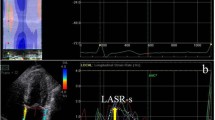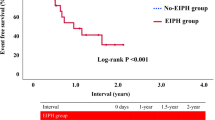Abstract
Exercise transthoracic echocardiography (ExE) was recently proposed to evaluate tolerance and help risk stratification of mitral regurgitation (MR). Few data are available on the feasibility of Doppler echocardiographic recordings at exercise in daily practice in both secondary and primary MR. Comprehensive resting and ExE were performed in 72 unselected patients (age 59 ± 15 years, 62 % men), with no or minimal symptoms, with at least moderate (mean effective regurgitant orifice area (ERO) = 36 ± 14 mm2) primary or secondary MR in two French university hospitals. At rest, quantification of ERO was more challenging in semi-supine position than in classic left lateral decubitus position (55/72; 76 % vs 66/72; 92 %; p = 0.012), particularly in mitral valve (MV) prolapse (35/47; 74 %). During exercise, ERO was only obtained in 30/55 (55 %) patients and was more difficult to assess in MV prolapse than in rheumatic or ischemic MR (respectively in 43, 67 and 88 %, p = 0.046). At peak exercise, ERO was more frequently obtained in symptomatic than asymptomatic patients (77 vs 37 %, p = 0.046) because peak heart rate was lower (113 ± 20 vs 133 ± 23 bpm, p = 0.026). Systolic pulmonary artery pressure (SPAP) was obtained in 69 patients (96 %) at rest and in 60 patients (83 %) at peak exercise (Pex). LV contractile reserve (CR), monitored in all patients (100 %), was found in 51/72 patients (71 %). In daily ExE, monitoring of the CR and SPAP appeared less challenging than MR quantification by the PISA method. Monitoring of ERO was more feasible in ischemic MR than in MV prolapse.





Similar content being viewed by others
Abbreviations
- CR:
-
Contractile reserve
- ERO:
-
Effective regurgitant orifice area
- ExE:
-
Exercise echocardiography
- LV:
-
Left ventricle
- LVEF:
-
Left ventricular ejection fraction
- MR:
-
Mitral regurgitation
- MV:
-
Mitral valve
- Pex:
-
Peak exercise
- PHT:
-
Pulmonary hypertension
- PISA:
-
Proximal isovelocity surface area
- SPAP:
-
Systolic pulmonary artery pressure
- W:
-
Watts
References
Nkomo VT, Gardin JM, Skelton TN, Gottdiener JS, Scott CG, Enriquez-Sarano M (2006) Burden of valvular heart diseases: a population-based study. Lancet 368:1005–1011
Nishimura RA, Otto CM, Bonow RO, Carabello BA, Erwin JP 3rd et al (2014) AHA/ACC guideline for the management of patients with valvular heart disease: executive summary: a report of the American College of Cardiology/American Heart Association Task Force on Practice Guidelines. J Am Coll Cardiol 2014(1097):1280–1287
Lancellotti P, Moura L, Pierard LA et al (2010) European Association of Echocardiography recommendations for the assessment of valvular regurgitation. Part 2: mitral and tricuspid regurgitation (native valve disease). Eur J Echocardiogr 11:307–332
Vahanian A, Alfieri O, Andreotti F, Antunes MJ, Baron-Esquivias G et al (2012) Guidelines on the management of valvular heart disease (version 2012): The Joint Task Force on the Management of Valvular Heart Disease of the European Society of Cardiology (ESC) and the European Association for Cardio-Thoracic Surgery (EACTS). Eur Heart J 33:2451–2496
Lancellotti P, Lebrun F, Pierard LA (2003) Determinants of exercise-induced changes in mitral regurgitation in patients with coronary artery disease and left ventricular dysfunction. J Am Coll Cardiol 42:1921–1928
Levy F, Donal E, Bière L, Szymanski C, Remadi JP et al (2014) Hemodynamic performance during exercise of the New St. Jude Trifecta Aortic Bioprosthesis: results from a French Multicenter Study. J Am Soc Echocardiogr 27(6):590–597
Maréchaux S, Pinçon C, Gal B, Kouakam C, Marquie C et al (2009) Functional mitral regurgitation at rest determines the acute hemodynamic response to cardiac resynchronization therapy during exercise: an acute exercise echocardiographic study. J Am Soc Echocardiogr 22(5):464–471
Lebrun F, Lancellotti P, Pierard LA (2001) Quantification of functional mitral regurgitation during bicycle exercise in patients with heart failure. J Am Coll Cardiol 38:1685–1692
Enriquez-Sarano M, Miller FA, Hayes SN, Bailey KR, Tajik J, Seward JB (1995) Effective mitral regurgitation orifice area: clinical use and pitfalls of the proximal isovelocity surface area method. J Am Coll Cardiol 25:703–709
Quiñones MA, Ott CM, Stoddard M, Waggoner A, Zoghbi WA (2002) Recommendations for quantification of Doppler echocardiography: a report from the Doppler quantification Task Force of the Nomenclature and Standards Committee of the American Society of Echocardiography. J Am Soc Echocardiogr 15(2):167–184
Lancellotti P, Tribouilloy C, Hagendorff A, Popescu BA, Edvardsen T et al (2013) Recommendations for the echocardiographic assessment of native valvular regurgitation: an executive summary from the European Association of Cardiovascular Imaging. Eur Heart J Cardiovasc Imaging 14(7):611–644
Mahjoub H, Levy F, Cassol M, Meimoun P, Peltier M et al (2009) Effects of age on pulmonary artery systolic pressure at rest and during exercise in normal adults. Eur J Echocardiogr 10:635–640
Enriquez-Sarano M, Avierinos JF, Messika-Zeitoun D, Detaint D, Capps M et al (2005) Quantitative determinants of the outcome of asymptomatic mitral regurgitation. N Engl J Med 352:875–883
Lancellotti P, Troisfontaines P, Toussaint AC, Pierard LA (2003) Prognostic importance of exercise-induced changes in mitral regurgitation in patients with chronic ischemic left ventricular dysfunction. Circulation 108:1713–1717
Magne J, Lancellotti P, Piérard LA (2010) Exercise pulmonary hypertension in asymptomatic degenerative mitral regurgitation. Circulation 122:33–41
Kusunose k, Popovic ZB, Motoki H, Marwick TH (2013) Prognostic significance of exercise-induced right ventricular dysfunction in asymptomatic degenerative mitral regurgitation. Circ Cardiovasc Imaging 6:167–176
Magne J, Lancellotti P, Pierard LA (2010) Exercise-induced changes in degenerative mitral regurgitation. J Am Coll Cardiol 56:300–309
Lebrun F, Lancellotti P, Pierard LA (2001) Quantification of functional mitral regurgitation during bicycle exercise in patients with heart failure. J Am Coll Cardiol 38(6):1685–1692
Hen MK, Bai JX, Marin J (1998) Changes in left ventricular wall stress during isometric and isotonic exercise in healthy men. Am J Cardiol 62:794–798
Leung DY, Griffin BP, Stewart WJ, Cosgrove DM 3rd, Thomas JD, Marwick TH (1996) Left ventricular function after valve repair for chronic mitral regurgitation: predictive value of preoperative assessment of contractile reserve by exercise echocardiography. J Am Coll Cardiol 28:1198–1205
Lee R, Haluska B, Leung DY, Case C, Mundy J, Marwick TH (2005) Functional and prognostic implications of left ventricular contractile reserve in patients with asymptomatic severe mitral regurgitation. Heart 91:1407–1412
Magne J, Mahjoub H, Dulgheru R, Pibarot P, Pierard LA, Lancellotti P (2013) Left ventricular contractile reserve in asymptomatic primary mitral regurgitation. Eur Heart J 10:1093
Conflict of interest
None.
Author information
Authors and Affiliations
Corresponding author
Additional information
Augustin Coisne and Franck Levy have contributed equally to this work.
Rights and permissions
About this article
Cite this article
Coisne, A., Levy, F., Malaquin, D. et al. Feasibility of Doppler hemodynamic evaluation of primary and secondary mitral regurgitation during exercise echocardiography. Int J Cardiovasc Imaging 31, 291–299 (2015). https://doi.org/10.1007/s10554-014-0550-5
Received:
Accepted:
Published:
Issue Date:
DOI: https://doi.org/10.1007/s10554-014-0550-5




